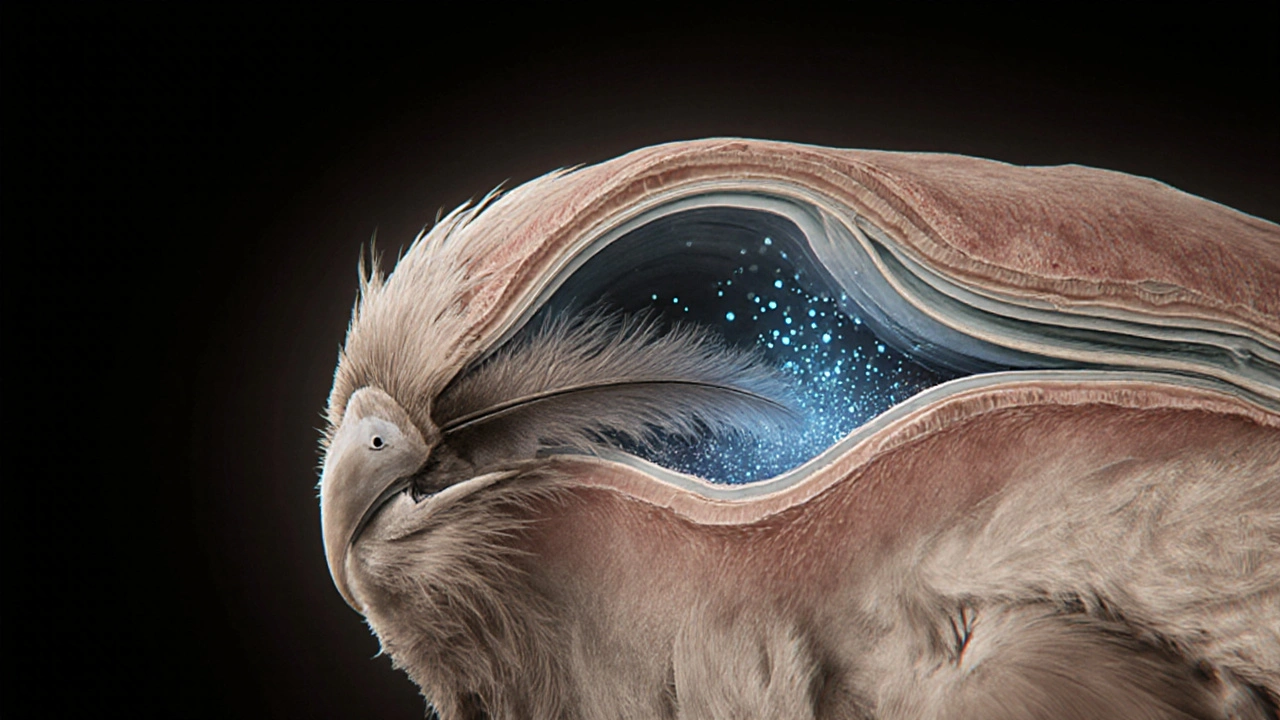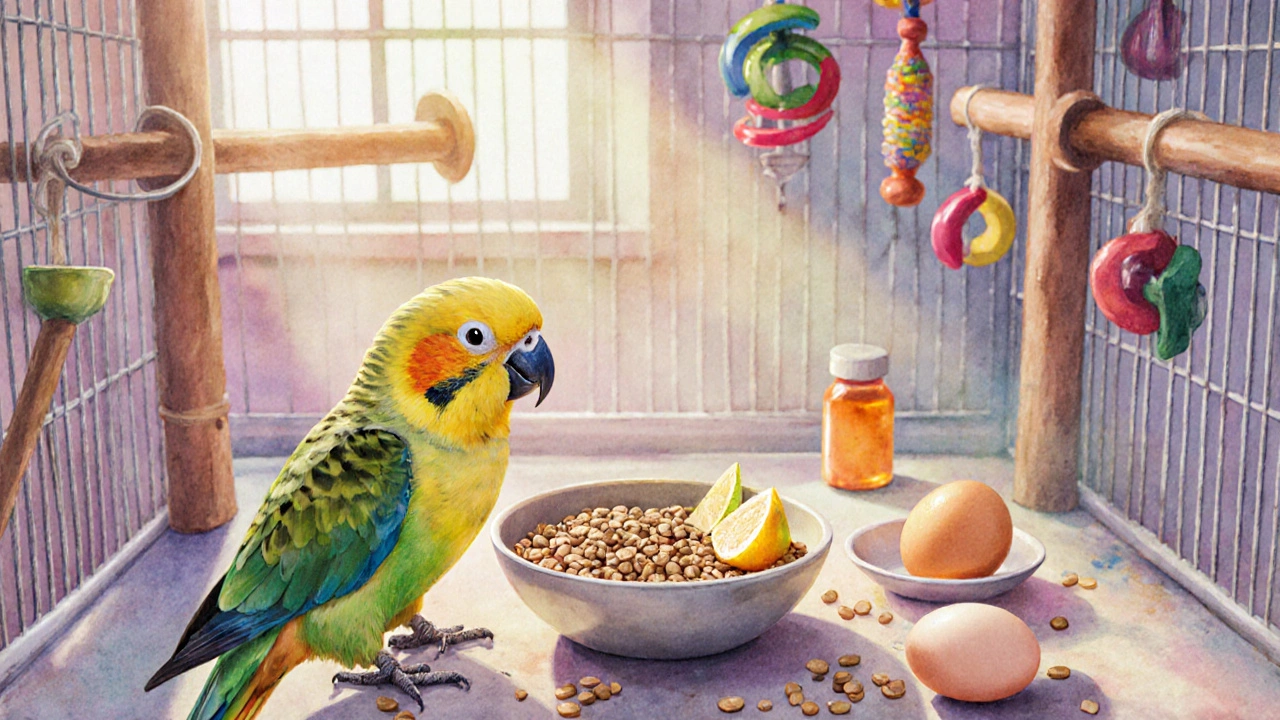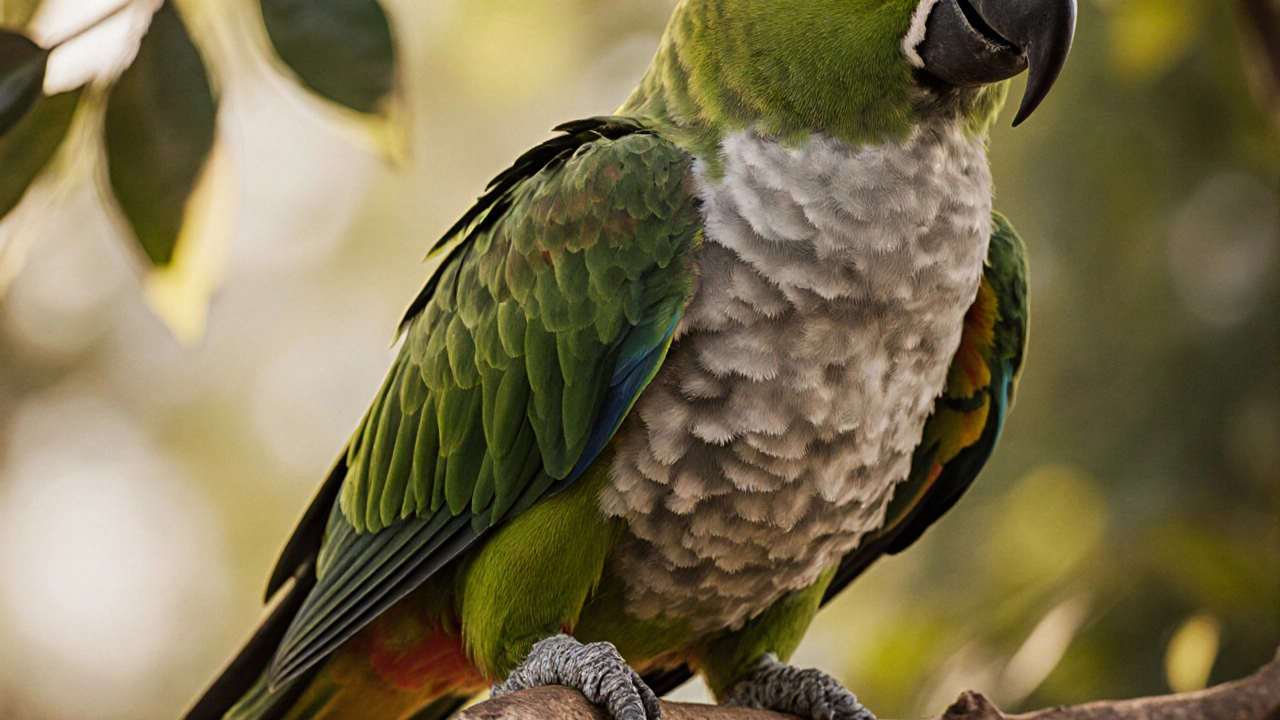Ever noticed a bird suddenly losing patches of feathers and wondered if it’s just another molt? The truth is, Deplumation and molting are often confused, but they signal very different things. Knowing how they differ can help pet owners, birdwatchers, and vets spot health issues early and keep feathered friends thriving.
Key Takeaways
- Molting is a normal, cyclic replacement of feathers; deplumation is abnormal feather loss.
- Hormones, nutrition, and season drive molting, while stress, parasites, and disease trigger deplumation.
- Identifying patterns-symmetrical vs. random, gradual vs. rapid-helps you tell the two apart.
- Proper diet, stress‑reduction, and regular health checks can prevent most cases of deplumation.
- When deplumation is suspected, a vet should evaluate for underlying health problems.
What Is Molting?
Molting is the natural, seasonal process where birds shed old feathers and grow new ones. It’s built into a bird’s life‑cycle and usually follows a predictable pattern. Most species have a primary “post‑breeding” molt and a secondary “pre‑breeding” molt, each regulated by hormones such as melatonin and testosterone.
The molt cycle starts deep in the feather follicle a tiny pocket of skin that produces each feather. As the follicle receives the right hormonal signals, the old feather weakens, detaches, and a new feather pushes up from the base. This process can take weeks to months, depending on species, age, and environmental conditions.
Typical signs of a healthy molt include:
- Symmetrical feather loss (e.g., both wings losing the same flight feather).
- Gradual progression-only a few feathers shed each day.
- New feather buds visible at the base of the lost feather.
- No signs of itching, redness, or skin inflammation.
Because molting is predictable, bird owners can plan to reduce stress during this period, such as avoiding major cage changes or loud noises.
What Is Deplumation?
Deplumation is the abnormal, often rapid loss of feathers that is not part of the regular molt cycle. It’s a red flag that something is wrong with the bird’s health or environment.
Unlike molting, deplumation rarely follows a symmetrical pattern. Feathers may fall out in irregular patches, sometimes leaving bald spots on the chest, back, or tail. The loss can be sudden-several feathers dropping in a single day-accompanied by skin irritation, bleeding, or scabbing.
Common triggers include:
- Stress: Relocation, loud noises, or overcrowding can push the bird’s adrenal glands into overdrive, releasing cortisol that weakens feather anchors.
- Parasites: Mites, lice, and feather‑eating insects bite at the feather base, causing it to break off.
- Nutrition deficiencies: Lack of essential amino acids, vitamins A, E, or biotin leads to weak keratin and feather breakage.
- Medical conditions: Liver disease, hormonal imbalances (e.g., hyperthyroidism), or skin infections like dermatitis cause feathers to fall out.
- Physical trauma: Feather plucking due to boredom or aggression.
Because deplumation often signals an underlying issue, a quick veterinary assessment is essential.

Side‑by‑Side Comparison
| Aspect | Molting | Deplumation |
|---|---|---|
| Cause | Hormonal cycle, seasonal change | Stress, parasites, disease, nutrition |
| Pattern | Symmetrical, predictable | Random, often asymmetrical |
| Speed | Gradual (weeks to months) | Rapid (hours to days) |
| Skin condition | Healthy, no inflammation | Redness, scabs, possible bleeding |
| Feather buds | Visible new growth | Often absent |
| Health implication | Normal, no treatment needed | Indicative of underlying problem |
How to Spot Deplumation Early
Even experienced bird keepers can miss early signs. Here’s a quick checklist you can run through during daily observation:
- Check for uneven feather loss-compare left and right sides.
- Run a gentle fingertip over the skin. Any raw spots, scabs, or itching?
- Look for feather buds. If none appear after a few days, suspect deplumation.
- Observe behavior. Is the bird unusually quiet, aggressive, or feather‑plucking?
- Monitor diet. Are you feeding a balanced mix of seeds, pellets, fruits, and vegetables?
If more than two items raise a red flag, schedule a vet visit. Early intervention can prevent permanent feather loss and secondary infections.
Preventing Deplumation: Practical Tips
Prevention blends good husbandry with proactive health monitoring. Below are actionable steps for both pet owners and backyard bird enthusiasts.
- Balanced Nutrition: Provide a diet rich in protein (e.g., boiled eggs, insect treats) and add a vitamin supplement containing biotin, vitaminA, and zinc.
- Stress Management: Keep the cage in a quiet area, avoid sudden moves, and give the bird regular out‑of‑cage exercise.
- Regular Parasite Checks: Perform a visual inspection weekly. Use a vet‑approved dusting powder for mite control.
- Veterinary Health Screenings: Annual blood work can catch liver or thyroid issues before feather loss appears.
- Enrichment: Rotate toys, provide foraging opportunities, and allow safe social interaction to reduce boredom‑induced plucking.
When you notice a single feather missing, don’t panic. One or two feathers can fall out naturally during a molt. The real concern rises when the loss spreads quickly or the skin looks irritated.

When to Involve a Veterinarian
Even with careful observation, some cases are tricky. A vet can perform:
- Skin scrapings to identify mites or fungal infections.
- Blood tests for liver enzymes, thyroid hormone levels, and nutritional deficiencies.
- Feather analysis (microscopy) to see if the shaft is weak or broken at the base.
- Radiographs if underlying bone injury is suspected.
Treatment will target the root cause-antiparasitic medication for mites, dietary adjustments for deficiencies, or hormone therapy for endocrine disorders. In severe cases, soft‑cage liners and protective ointments help the skin heal while new feathers grow back.
Frequently Asked Questions
Can a bird molt and experience deplumation at the same time?
Yes. A bird in the middle of a normal molt can still develop deplumation if it encounters stress, parasites, or nutritional gaps. In such cases, the feather loss will appear more chaotic than the orderly pattern of a regular molt.
How long does it take for a bird to regrow feathers after deplumation?
Regrowth depends on the bird’s age, species, and overall health. Generally, new feathers can appear within 2‑4 weeks if the underlying issue is resolved, but full plumage restoration may take several months.
Is feather‑plucking considered deplumation?
Feather‑plucking is a behavioral form of deplumation. The bird removes its own feathers, often due to boredom, stress, or medical pain. While the mechanism differs from parasite‑induced loss, the outcome-abnormal feather loss-is the same.
Can diet alone prevent deplumation?
A balanced diet is foundational, but it’s not a cure‑all. Stress reduction, parasite control, and regular health checks are equally important. Think of diet as one piece of a larger prevention puzzle.
What are the most common parasites that cause deplumation?
The primary culprits are feather mites and lice. Both embed themselves near the feather base and feed on keratin or blood, weakening the attachment point.
Should I trim my bird’s wings if it’s molting?
Never trim wings during a molt. The bird needs the remaining flight feathers for balance and safety. If a wing is damaged, consult a vet - they can safely remove only the compromised feather.
Bottom Line
Molting is the bird’s built‑in renovation schedule; deplumation is the warning light that something needs fixing. By watching for patterns, keeping nutrition solid, and acting quickly when abnormal feather loss appears, you give your feathered companion the best chance at a full, healthy plumage.


9 Comments
Christopher Jimenez
While the article does a decent job of delineating molting from deplumation, it glosses over the evolutionary implications of feather turnover. One might argue that the very existence of a rapid, stress‑induced feather loss suggests an adaptive emergency response, not merely a pathological mishap. Moreover, the piece underestimates the role of endocrine feedback loops that can trigger both processes simultaneously. In most avian textbooks, the term "deplumation" is scarcely mentioned, yet field ornithologists have recorded it in over a dozen wild species during habitat disruption. Hence, the binary framing of "normal vs abnormal" is an oversimplification that merits deeper scrutiny.
Olivia Christensen
Thanks for breaking this down so clearly! Your checklist is super handy for anyone keeping a parrot or even just watching backyard birds 😊. I especially appreciate the reminder to look for feather buds-that little detail can make a huge difference in catching deplumation early. Keeping a balanced diet and a low‑stress environment does sound simple, but it's often the hardest part of pet care. Great work, and I’ll definitely share this with fellow bird lovers.
Lauren W
One must, undeniably, question the premise that molting is merely a "seasonal renovation"; indeed, the very language employed by the author betrays a complacent acceptance of avian physiology, which, I would argue, is far more nuanced-and, frankly, more fascinating-than the article suggests; the omission of hormonal antagonists, for instance, is a glaring oversight, and the reliance on layman terms muddies the scientific discourse, thereby reducing the potential impact of such an otherwise valuable piece.
Crystal Doofenschmirtz
I see where you're coming from, and it's true that the hormonal intricacies deserve more attention. Still, the article's primary goal seems to be practical guidance for bird owners rather than a deep endocrinological treatise. By focusing on observable signs and actionable steps, it stays accessible without alienating readers who aren't specialists.
Pankaj Kumar
Spot on! Adding a few protein‑rich treats-think boiled egg yolk or mealworms-can boost keratin synthesis, which is the building block of strong feathers. Pair that with regular foraging toys to keep stress levels low, and you’ve got a recipe for thriving plumage. Remember, consistency is key; even a small daily tweak can prevent the cascade that leads to deplumation.
Harshitha Uppada
i guess the article is ok but kinda boring lol. they could've added some real stories like that one bird in nyc that lost all its tail after a thunderstorm. also, why they keep using big words when simple would do?
Randy Faulk
The distinction between molting and deplumation, while ostensibly straightforward, carries significant implications for avian health management. Molting, as delineated in the literature, constitutes a hormonally orchestrated renewal process that aligns with the bird's reproductive cycle and environmental cues. Conversely, deplumation represents a pathological deviation, often precipitated by exogenous stressors or endogenous disease states. The article correctly identifies symmetrical feather loss and gradual progression as hallmarks of a normal molt. However, it could further elaborate on the diagnostic value of dermal thermography in differentiating the two conditions.
Moreover, the integumentary response to parasitic infestation frequently masquerades as deplumation, necessitating meticulous microscopic examination. Veterinary practitioners should therefore integrate hemogram analyses to detect subclinical infections that may not manifest overtly. Nutritional adequacy, especially concerning essential amino acids and micronutrients such as biotin, cannot be overstated in preventing feather fragility. A diet supplemented with high‑quality protein sources and calibrated vitamin complexes has been shown to reduce incidence of abnormal feather loss. Stress mitigation strategies, including environmental enrichment and consistent circadian lighting, further bolster the bird's physiological resilience.
It is also prudent to schedule periodic health assessments, ideally biannually, to monitor hepatic and thyroid function indices. Early identification of hormonal imbalances permits timely therapeutic intervention, thereby averting irreversible plumage damage. The utilization of feather bud observation as a non‑invasive metric offers a practical tool for both clinicians and caretakers. In practice, a systematic checklist, akin to the one presented, should be incorporated into routine husbandry protocols. Ultimately, the synthesis of vigilant observation, balanced nutrition, and proactive veterinary oversight constitutes the optimal approach to preserving avian integumentary integrity. By adhering to these principles, bird enthusiasts can ensure that feather loss remains a natural, aesthetic transition rather than a harbinger of disease.
Brandi Hagen
OMG, this is exactly the kind of deep‑dive I live for! 🌟 You've turned a simple checklist into an epic saga of feather science, and I am here for every dramatic twist. From the microscopic parasites plotting a coup to the hormonal dramas that could rival a soap opera, you’ve covered it all with flair. Keep sprinkling those emojis-nothing says "avian health" like a well‑placed 💊 and a soaring eagle 🦅.
isabel zurutuza
Sure, because counting feather buds is what I do on weekends.